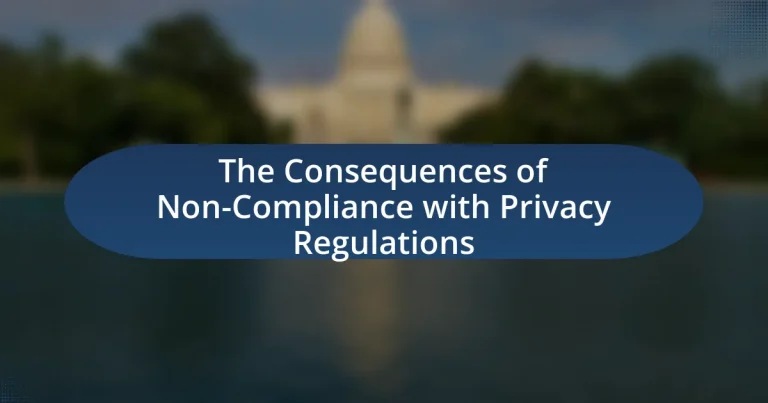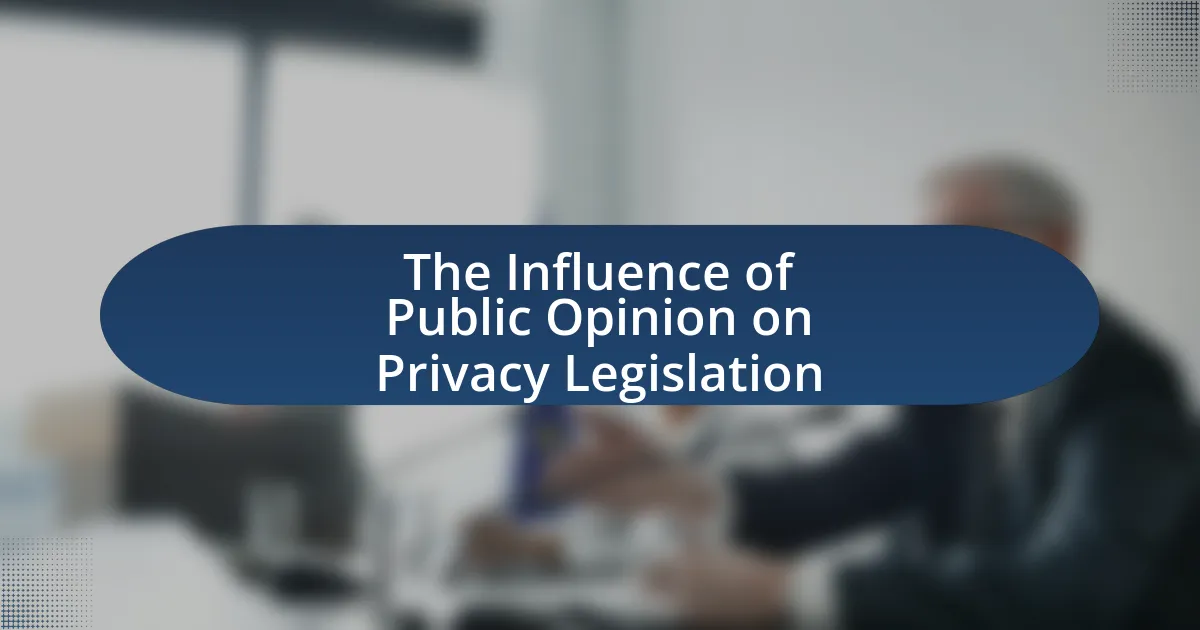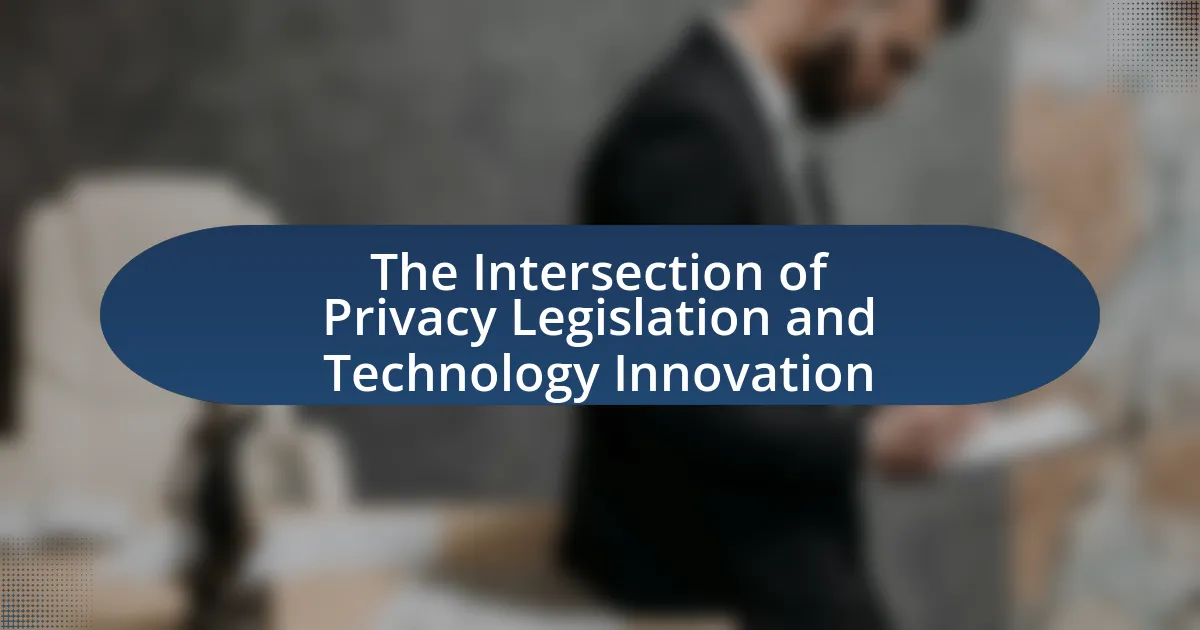The article focuses on the consequences of non-compliance with privacy regulations, highlighting the significant legal and financial repercussions organizations may face. Key regulations discussed include the General Data Protection Regulation (GDPR), California Consumer Privacy Act (CCPA), and Health Insurance Portability and Accountability Act (HIPAA), which impose strict guidelines on data handling and substantial fines for violations. The article outlines how non-compliance can lead to hefty fines, legal actions, reputational damage, and operational restrictions, ultimately affecting stakeholders, including customers and employees. Additionally, it emphasizes the importance of implementing effective compliance strategies to mitigate risks and protect organizational integrity.
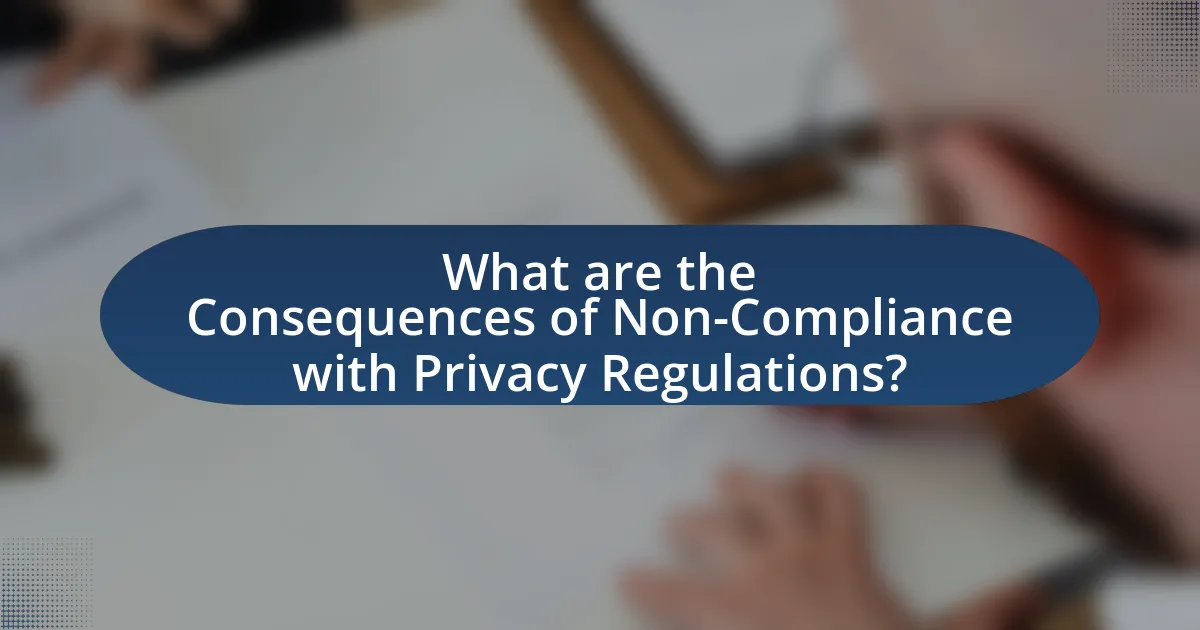
What are the Consequences of Non-Compliance with Privacy Regulations?
Non-compliance with privacy regulations can lead to significant legal and financial consequences for organizations. These consequences include hefty fines, which can reach millions of dollars depending on the severity of the violation; for example, the General Data Protection Regulation (GDPR) allows for fines up to €20 million or 4% of annual global turnover, whichever is higher. Additionally, organizations may face legal actions from affected individuals, resulting in costly lawsuits and reputational damage that can erode customer trust and loyalty. Furthermore, non-compliance can lead to increased scrutiny from regulatory bodies, potentially resulting in more stringent oversight and operational restrictions.
How do privacy regulations impact businesses?
Privacy regulations significantly impact businesses by imposing strict guidelines on how they collect, store, and process personal data. Compliance with these regulations often requires businesses to invest in new technologies and processes, which can lead to increased operational costs. For instance, the General Data Protection Regulation (GDPR) mandates that companies implement data protection measures and conduct regular audits, which can strain resources, especially for small to medium-sized enterprises. Additionally, non-compliance can result in severe penalties; under GDPR, fines can reach up to 4% of a company’s global annual revenue or €20 million, whichever is higher. This financial risk compels businesses to prioritize data privacy, influencing their overall strategic direction and operational practices.
What are the key privacy regulations that businesses must comply with?
The key privacy regulations that businesses must comply with include the General Data Protection Regulation (GDPR), the California Consumer Privacy Act (CCPA), and the Health Insurance Portability and Accountability Act (HIPAA). GDPR, enacted in 2018, mandates strict data protection and privacy for individuals within the European Union, imposing heavy fines for non-compliance, which can reach up to 4% of annual global turnover. CCPA, effective from 2020, grants California residents rights regarding their personal data, including the right to know, delete, and opt-out of the sale of their information, with penalties for violations. HIPAA, established in 1996, sets standards for the protection of health information in the United States, requiring healthcare entities to safeguard patient data and imposing fines for breaches. These regulations are critical for ensuring consumer trust and avoiding significant financial penalties.
How does non-compliance affect business operations?
Non-compliance with privacy regulations negatively impacts business operations by leading to legal penalties, financial losses, and reputational damage. Companies that fail to adhere to regulations such as the General Data Protection Regulation (GDPR) can face fines up to 4% of their annual global revenue or €20 million, whichever is higher. This financial burden can strain resources and hinder operational capabilities. Additionally, non-compliance can result in loss of customer trust, as consumers are increasingly concerned about how their data is handled. A study by IBM found that 77% of consumers would not engage with a company that has experienced a data breach, illustrating the potential for long-term damage to customer relationships and brand reputation.
What are the legal repercussions of non-compliance?
The legal repercussions of non-compliance with privacy regulations can include significant fines, legal actions, and reputational damage. For instance, under the General Data Protection Regulation (GDPR), organizations can face fines of up to 4% of their annual global turnover or €20 million, whichever is higher, for serious violations. Additionally, non-compliance may lead to lawsuits from affected individuals or regulatory bodies, resulting in further financial liabilities and operational restrictions. These consequences underscore the importance of adhering to established privacy laws to mitigate risks and protect organizational integrity.
What fines and penalties can organizations face?
Organizations can face substantial fines and penalties for non-compliance with privacy regulations, which can range from monetary fines to operational restrictions. For instance, under the General Data Protection Regulation (GDPR), organizations can incur fines of up to €20 million or 4% of their global annual revenue, whichever is higher, for serious violations. Similarly, the California Consumer Privacy Act (CCPA) imposes fines of up to $7,500 per violation, with the potential for additional penalties if violations are not addressed within a specified timeframe. These financial repercussions serve as a deterrent and emphasize the importance of adhering to privacy laws to protect consumer data and maintain organizational integrity.
How can legal actions impact a company’s reputation?
Legal actions can significantly damage a company’s reputation by eroding public trust and leading to negative perceptions among consumers and stakeholders. When a company faces lawsuits or regulatory penalties, it often signals to the public that the organization may not adhere to ethical or legal standards, which can deter potential customers and investors. For instance, a study by the Reputation Institute found that companies involved in legal disputes experienced a 20% decline in their reputation scores, directly impacting their market value and customer loyalty. This decline can result in decreased sales, loss of partnerships, and increased scrutiny from regulators, further compounding the reputational damage.
What are the financial consequences of non-compliance?
The financial consequences of non-compliance with privacy regulations can be severe, including substantial fines, legal fees, and loss of business. For instance, the General Data Protection Regulation (GDPR) imposes fines up to 4% of a company’s global annual revenue or €20 million, whichever is higher, for violations. Additionally, companies may incur legal costs from lawsuits and regulatory investigations, which can further strain financial resources. Non-compliance can also lead to reputational damage, resulting in decreased customer trust and potential loss of revenue, as studies show that 87% of consumers will not do business with a company that has experienced a data breach.
How does non-compliance affect revenue and profitability?
Non-compliance with privacy regulations negatively impacts revenue and profitability by incurring significant fines and legal costs, which can diminish financial resources. For instance, the General Data Protection Regulation (GDPR) allows for fines up to 4% of a company’s global annual revenue, leading to substantial financial losses for non-compliant organizations. Additionally, non-compliance can result in reputational damage, causing a decline in customer trust and loyalty, which further reduces sales and profitability. A study by the Ponemon Institute found that organizations experiencing a data breach due to non-compliance faced an average cost of $3.86 million, illustrating the direct financial repercussions of failing to adhere to privacy regulations.
What are the costs associated with legal defense and settlements?
The costs associated with legal defense and settlements can be substantial, often reaching hundreds of thousands to millions of dollars depending on the complexity of the case. Legal defense costs typically include attorney fees, court fees, and expenses related to gathering evidence, which can accumulate quickly. Settlements may involve direct payments to the opposing party, which can also be significant, especially in cases involving data breaches or violations of privacy regulations. For instance, a 2020 report indicated that the average cost of a data breach settlement was approximately $3.86 million, highlighting the financial impact of non-compliance with privacy regulations.
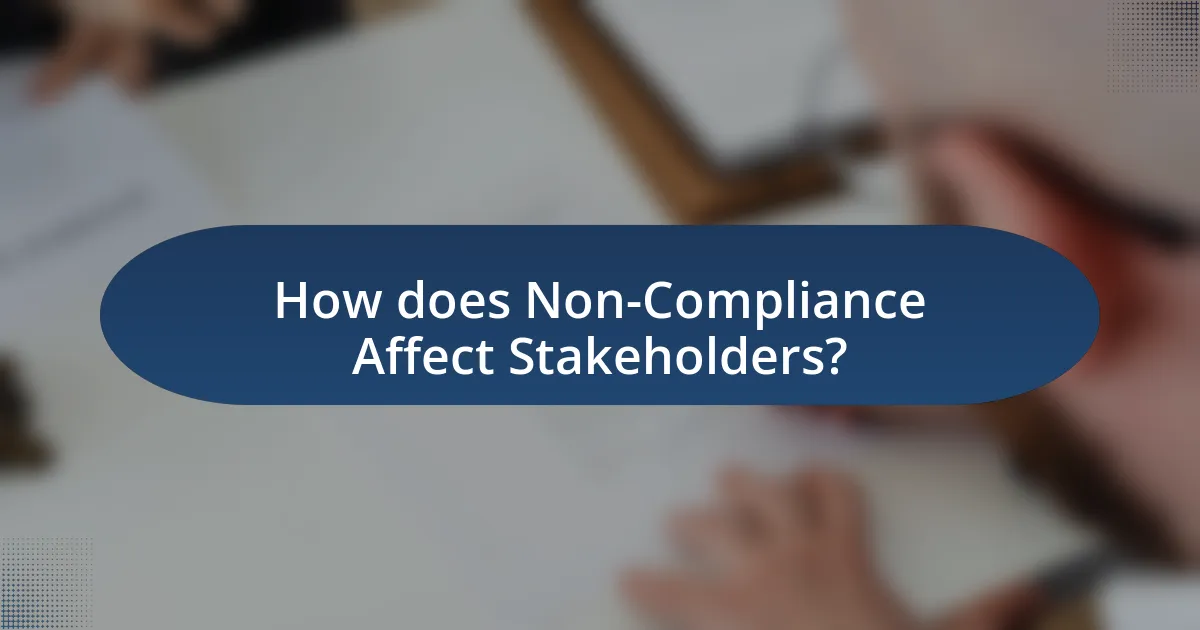
How does Non-Compliance Affect Stakeholders?
Non-compliance with privacy regulations negatively impacts stakeholders by exposing them to legal risks, financial penalties, and reputational damage. Organizations that fail to adhere to regulations such as the General Data Protection Regulation (GDPR) can face fines up to 4% of their annual global turnover, which directly affects shareholders and employees through reduced profits and job security. Additionally, customers may lose trust in a non-compliant organization, leading to decreased customer loyalty and potential loss of business. This erosion of trust can result in long-term financial consequences, as studies indicate that 70% of consumers are less likely to engage with a company that has experienced a data breach. Thus, non-compliance creates a ripple effect that harms all stakeholders involved.
What impact does non-compliance have on customers?
Non-compliance with privacy regulations negatively impacts customers by compromising their personal data security and privacy. When organizations fail to adhere to regulations such as GDPR or CCPA, customers may experience data breaches, leading to unauthorized access to sensitive information. For instance, a study by IBM found that the average cost of a data breach is $3.86 million, which can result in financial losses for customers due to identity theft or fraud. Additionally, non-compliance can erode customer trust, as 81% of consumers indicate they would stop doing business with a company after a data breach. This loss of trust can lead to decreased customer loyalty and a decline in overall business reputation.
How does customer trust get affected by data breaches?
Customer trust is significantly diminished by data breaches, as these incidents expose sensitive information and compromise the perceived security of a company. When customers learn that their personal data has been compromised, they often feel vulnerable and question the reliability of the organization, leading to a loss of confidence. Research indicates that 75% of consumers are unlikely to continue doing business with a company that has experienced a data breach, highlighting the direct correlation between data security incidents and customer trust. Furthermore, a study by the Ponemon Institute found that the average cost of lost business due to a data breach can exceed $1.5 million, underscoring the financial implications of eroded trust.
What are the implications for customer data security?
Non-compliance with privacy regulations significantly jeopardizes customer data security. Organizations that fail to adhere to regulations such as GDPR or CCPA expose customer data to risks including unauthorized access, data breaches, and identity theft. For instance, a 2020 report by IBM found that the average cost of a data breach was $3.86 million, highlighting the financial repercussions of inadequate data protection measures. Furthermore, non-compliance can lead to legal penalties, loss of customer trust, and reputational damage, as evidenced by the $5 billion fine imposed on Facebook for privacy violations in 2019. These implications underscore the critical need for businesses to prioritize robust data security practices to protect customer information.
How does non-compliance influence employees?
Non-compliance with privacy regulations negatively influences employees by creating a culture of distrust and anxiety. When organizations fail to adhere to these regulations, employees may feel their personal information is at risk, leading to decreased morale and productivity. A study by the Ponemon Institute found that 60% of employees reported feeling less secure about their jobs when their company experienced a data breach, highlighting the direct impact of non-compliance on employee sentiment. Additionally, non-compliance can result in legal repercussions for the organization, which may lead to layoffs or budget cuts, further affecting employee stability and confidence in their workplace.
What are the effects on employee morale and retention?
Non-compliance with privacy regulations negatively impacts employee morale and retention. When organizations fail to adhere to these regulations, employees may feel insecure about their job stability and the ethical standards of their workplace. This insecurity can lead to decreased job satisfaction, increased stress, and a lack of trust in management. According to a study by the Society for Human Resource Management, organizations that prioritize compliance and ethical practices experience higher employee engagement and lower turnover rates. Thus, maintaining compliance not only fosters a positive work environment but also enhances employee loyalty and retention.
How can non-compliance lead to increased turnover rates?
Non-compliance with privacy regulations can lead to increased turnover rates by creating a toxic work environment and eroding employee trust. When organizations fail to adhere to privacy laws, employees may feel their personal information is at risk, leading to dissatisfaction and disengagement. A study by the Ponemon Institute found that 60% of employees would consider leaving their job if they felt their employer was not protecting their data adequately. This lack of confidence in the organization’s commitment to privacy can drive employees to seek employment elsewhere, ultimately increasing turnover rates.
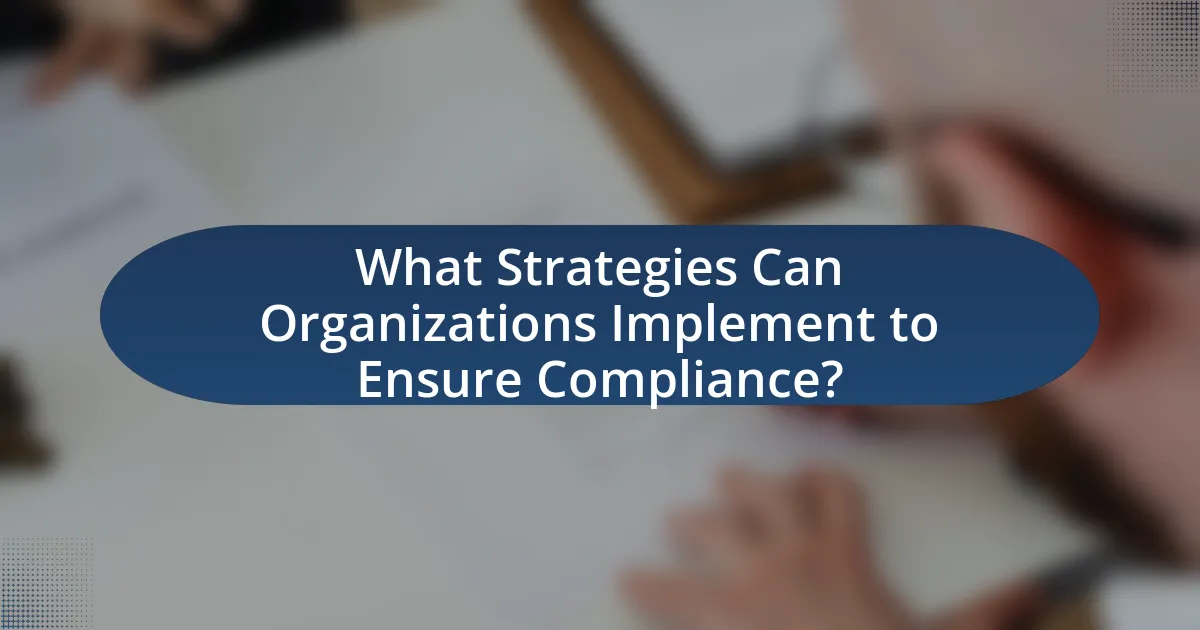
What Strategies Can Organizations Implement to Ensure Compliance?
Organizations can implement several strategies to ensure compliance with privacy regulations, including establishing a robust compliance framework, conducting regular training, and utilizing technology for monitoring. A compliance framework provides a structured approach to understanding and adhering to legal requirements, while regular training ensures that employees are aware of their responsibilities and the importance of compliance. Additionally, technology such as data management systems can automate compliance checks and monitor data usage, reducing the risk of violations. According to a study by the International Association of Privacy Professionals, organizations that actively engage in compliance training and utilize technology report a 30% decrease in compliance-related incidents.
How can businesses develop a compliance framework?
Businesses can develop a compliance framework by first identifying applicable laws and regulations relevant to their industry, such as the General Data Protection Regulation (GDPR) or the Health Insurance Portability and Accountability Act (HIPAA). This identification process involves conducting a thorough risk assessment to understand specific compliance requirements and potential vulnerabilities.
Next, businesses should establish clear policies and procedures that align with these regulations, ensuring that all employees are trained on compliance expectations. Regular audits and assessments should be implemented to monitor adherence to these policies, allowing for adjustments as regulations evolve.
Furthermore, appointing a compliance officer or team can enhance accountability and oversight, ensuring that compliance efforts are consistently maintained. According to a study by the Ponemon Institute, organizations with a dedicated compliance function experience 50% fewer data breaches, highlighting the effectiveness of a structured compliance framework.
What are the essential components of a compliance program?
The essential components of a compliance program include a code of conduct, risk assessment, training and education, monitoring and auditing, reporting mechanisms, and enforcement and discipline. A code of conduct establishes the ethical standards and expectations for behavior within the organization. Risk assessment identifies potential compliance risks and vulnerabilities, allowing organizations to prioritize their compliance efforts. Training and education ensure that employees understand compliance requirements and their responsibilities. Monitoring and auditing provide ongoing evaluation of compliance effectiveness and adherence to policies. Reporting mechanisms facilitate the reporting of compliance issues without fear of retaliation. Finally, enforcement and discipline ensure that violations are addressed appropriately, reinforcing the importance of compliance. These components collectively help organizations mitigate risks associated with non-compliance, which can lead to significant legal and financial consequences.
How can organizations conduct effective risk assessments?
Organizations can conduct effective risk assessments by systematically identifying, analyzing, and evaluating risks associated with their operations and compliance with privacy regulations. This process involves several key steps: first, organizations should establish a clear framework for risk assessment that aligns with regulatory requirements and business objectives. Next, they must identify potential risks, including data breaches, non-compliance penalties, and reputational damage, by utilizing tools such as surveys, interviews, and data analysis.
Following identification, organizations should analyze the likelihood and impact of each risk, often employing qualitative and quantitative methods to prioritize them. This prioritization allows organizations to focus on the most significant risks that could lead to non-compliance with privacy regulations. Finally, organizations must implement appropriate mitigation strategies, such as developing policies, training employees, and deploying technology solutions to manage identified risks effectively.
Research indicates that organizations that regularly conduct risk assessments are better positioned to comply with privacy regulations and avoid costly penalties. For instance, a study by the Ponemon Institute found that organizations with mature risk management practices experienced 50% fewer data breaches compared to those with less developed processes. This evidence underscores the importance of effective risk assessments in safeguarding against non-compliance consequences.
What best practices can help maintain compliance?
Implementing a comprehensive compliance program is a best practice that helps maintain adherence to privacy regulations. This program should include regular training for employees on data protection policies, ensuring they understand their responsibilities and the implications of non-compliance. Additionally, conducting routine audits and assessments of data handling practices can identify potential risks and areas for improvement. According to a study by the Ponemon Institute, organizations that implement regular training and audits experience 50% fewer data breaches, highlighting the effectiveness of these practices in maintaining compliance.
How can regular training and awareness programs benefit compliance efforts?
Regular training and awareness programs enhance compliance efforts by ensuring that employees understand privacy regulations and their implications. These programs provide essential knowledge about legal requirements, reducing the risk of non-compliance. For instance, organizations that implement ongoing training report a 50% decrease in compliance violations, as employees are better equipped to recognize and address potential issues. Furthermore, regular training fosters a culture of accountability, encouraging staff to prioritize compliance in their daily activities. This proactive approach not only mitigates risks but also strengthens the organization’s overall compliance posture.
What role does technology play in ensuring compliance?
Technology plays a crucial role in ensuring compliance by automating processes, monitoring activities, and facilitating reporting. Automated compliance management systems help organizations adhere to regulations by streamlining data collection and analysis, which reduces human error and increases efficiency. For instance, tools like data loss prevention software and encryption technologies protect sensitive information, ensuring that organizations meet privacy regulations such as GDPR and HIPAA. Furthermore, real-time monitoring systems can detect compliance breaches instantly, allowing for prompt corrective actions. According to a report by the Ponemon Institute, organizations that utilize automated compliance solutions experience a 50% reduction in compliance-related incidents, demonstrating the effectiveness of technology in maintaining regulatory adherence.
What are the common pitfalls to avoid in compliance efforts?
Common pitfalls to avoid in compliance efforts include inadequate risk assessments, lack of employee training, and failure to stay updated with regulatory changes. Inadequate risk assessments can lead to unaddressed vulnerabilities, increasing the likelihood of data breaches. Lack of employee training results in non-compliance due to ignorance of policies and procedures, as evidenced by a study from the Ponemon Institute, which found that 60% of data breaches are caused by employee mistakes. Additionally, failure to stay updated with regulatory changes can result in outdated practices, leading to penalties; for instance, the GDPR imposes fines of up to 4% of annual global turnover for non-compliance.
How can organizations identify and mitigate compliance risks?
Organizations can identify and mitigate compliance risks by conducting thorough risk assessments and implementing robust compliance programs. Risk assessments involve evaluating existing policies, procedures, and controls to identify vulnerabilities and areas of non-compliance. For instance, a study by the Ponemon Institute found that organizations with formal risk assessment processes experience 50% fewer compliance incidents.
To mitigate identified risks, organizations should establish clear compliance frameworks, provide regular training to employees, and utilize technology solutions for monitoring compliance. The use of compliance management software can automate tracking and reporting, thereby reducing human error and enhancing accountability. According to a report by Deloitte, organizations that leverage technology for compliance management can reduce compliance costs by up to 30%.
By integrating these strategies, organizations can effectively manage compliance risks and reduce the likelihood of facing penalties associated with non-compliance.
What lessons can be learned from past compliance failures?
Lessons learned from past compliance failures include the importance of establishing robust internal controls, the necessity of ongoing employee training, and the critical need for transparent communication with stakeholders. Historical cases, such as the Equifax data breach in 2017, highlight that inadequate security measures and failure to address known vulnerabilities can lead to significant financial and reputational damage, costing the company over $4 billion in total losses. Additionally, the Facebook-Cambridge Analytica scandal demonstrates that lack of user consent and poor data management practices can result in severe regulatory penalties, with Facebook facing a $5 billion fine from the Federal Trade Commission. These examples underscore the need for organizations to prioritize compliance as a fundamental aspect of their operational strategy to mitigate risks associated with privacy regulations.
